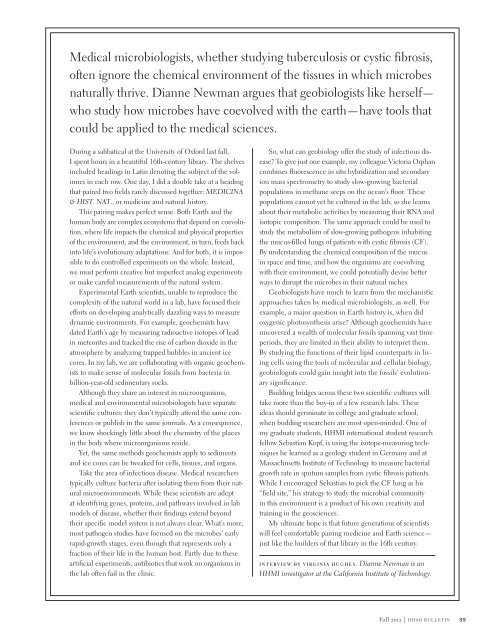Download PDF - Howard Hughes Medical Institute
Download PDF - Howard Hughes Medical Institute
Download PDF - Howard Hughes Medical Institute
You also want an ePaper? Increase the reach of your titles
YUMPU automatically turns print PDFs into web optimized ePapers that Google loves.
<strong>Medical</strong> microbiologists, whether studying tuberculosis or cystic fibrosis,<br />
often ignore the chemical environment of the tissues in which microbes<br />
naturally thrive. Dianne Newman argues that geobiologists like herself—<br />
who study how microbes have coevolved with the earth—have tools that<br />
could be applied to the medical sciences.<br />
During a sabbatical at the University of Oxford last fall,<br />
I spent hours in a beautiful 16th-century library. The shelves<br />
included headings in Latin denoting the subject of the volumes<br />
in each row. One day, I did a double take at a heading<br />
that paired two fields rarely discussed together: MEDICINA<br />
& HIST. NAT., or medicine and natural history.<br />
This pairing makes perfect sense. Both Earth and the<br />
human body are complex ecosystems that depend on coevolution,<br />
where life impacts the chemical and physical properties<br />
of the environment, and the environment, in turn, feeds back<br />
into life’s evolutionary adaptations. And for both, it is impossible<br />
to do controlled experiments on the whole. Instead,<br />
we must perform creative but imperfect analog experiments<br />
or make careful measurements of the natural system.<br />
Experimental Earth scientists, unable to reproduce the<br />
complexity of the natural world in a lab, have focused their<br />
efforts on developing analytically dazzling ways to measure<br />
dynamic environments. For example, geochemists have<br />
dated Earth’s age by measuring radioactive isotopes of lead<br />
in meteorites and tracked the rise of carbon dioxide in the<br />
atmosphere by analyzing trapped bubbles in ancient ice<br />
cores. In my lab, we are collaborating with organic geochemists<br />
to make sense of molecular fossils from bacteria in<br />
billion-year-old sedimentary rocks.<br />
Although they share an interest in microorganisms,<br />
medical and environmental microbiologists have separate<br />
scientific cultures: they don’t typically attend the same conferences<br />
or publish in the same journals. As a consequence,<br />
we know shockingly little about the chemistry of the places<br />
in the body where microorganisms reside.<br />
Yet, the same methods geochemists apply to sediments<br />
and ice cores can be tweaked for cells, tissues, and organs.<br />
Take the area of infectious disease. <strong>Medical</strong> researchers<br />
typically culture bacteria after isolating them from their natural<br />
microenvironments. While these scientists are adept<br />
at identifying genes, proteins, and pathways involved in lab<br />
models of disease, whether their findings extend beyond<br />
their specific model system is not always clear. What’s more,<br />
most pathogen studies have focused on the microbes’ early<br />
rapid-growth stages, even though that represents only a<br />
fraction of their life in the human host. Partly due to these<br />
artificial experiments, antibiotics that work on organisms in<br />
the lab often fail in the clinic.<br />
So, what can geobiology offer the study of infectious disease?<br />
To give just one example, my colleague Victoria Orphan<br />
combines fluorescence in situ hybridization and secondary<br />
ion mass spectrometry to study slow-growing bacterial<br />
populations in methane seeps on the ocean’s floor. These<br />
populations cannot yet be cultured in the lab, so she learns<br />
about their metabolic activities by measuring their RNA and<br />
isotopic composition. The same approach could be used to<br />
study the metabolism of slow-growing pathogens inhabiting<br />
the mucus-filled lungs of patients with cystic fibrosis (CF).<br />
By understanding the chemical composition of the mucus<br />
in space and time, and how the organisms are coevolving<br />
with their environment, we could potentially devise better<br />
ways to disrupt the microbes in their natural niches.<br />
Geobiologists have much to learn from the mechanistic<br />
approaches taken by medical microbiologists, as well. For<br />
example, a major question in Earth history is, when did<br />
oxygenic photosynthesis arise? Although geochemists have<br />
uncovered a wealth of molecular fossils spanning vast time<br />
periods, they are limited in their ability to interpret them.<br />
By studying the functions of their lipid counterparts in living<br />
cells using the tools of molecular and cellular biology,<br />
geobiologists could gain insight into the fossils’ evolutionary<br />
significance.<br />
Building bridges across these two scientific cultures will<br />
take more than the buy-in of a few research labs. These<br />
ideas should germinate in college and graduate school,<br />
when budding researchers are most open-minded. One of<br />
my graduate students, HHMI international student research<br />
fellow Sebastian Kopf, is using the isotope-measuring techniques<br />
he learned as a geology student in Germany and at<br />
Massachusetts <strong>Institute</strong> of Technology to measure bacterial<br />
growth rate in sputum samples from cystic fibrosis patients.<br />
While I encouraged Sebastian to pick the CF lung as his<br />
“field site,” his strategy to study the microbial community<br />
in this environment is a product of his own creativity and<br />
training in the geosciences.<br />
My ultimate hope is that future generations of scientists<br />
will feel comfortable pairing medicine and Earth science—<br />
just like the builders of that library in the 16th century.<br />
Interview by Virginia <strong>Hughes</strong>. Dianne Newman is an<br />
HHMI investigator at the California <strong>Institute</strong> of Technology.<br />
Fall 2o12 | h h m i b u l l e t i n<br />
35
















